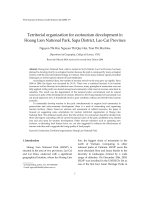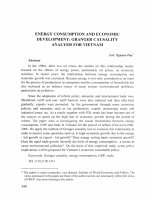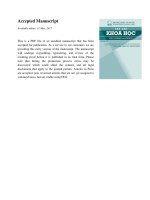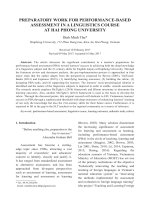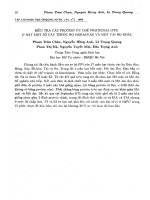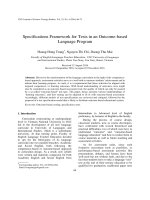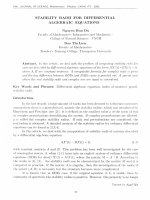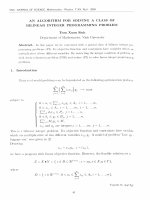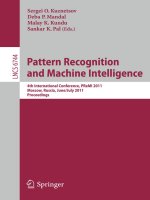DSpace at VNU: Territorial organization for ecotourism development in Hoang Lien National Park, Sa Pa District, Lao Cai Province
Bạn đang xem bản rút gọn của tài liệu. Xem và tải ngay bản đầy đủ của tài liệu tại đây (1.22 MB, 9 trang )
VNU Journal of Science, E arth Sciences 24 (2008) 1-9
Territorial organization for ecotourism development in
Hoang Lien National Park, Sapa District, Lao Cai Province
N g u y e n T h i H a i, N g u y e n T h i Q u y H o i, T r a n T h i M a i H o a
Department o/Geography, College o f Science, VNU
R eceived 8 M arch 2008; reccived in revised form 24 Ju n e 2008
A bstract. H o a n g Lien N ational Park, vvhat is located in Sa P a D istrict, Lao C ai P rovince, h as been
p lan n cd to d c v c lo p priority in ccological to u rism because th e p a rk is co m p o sed by m an y ecological
system s vvith th c m ost d iv ersiío rm biology in V ietnam . H ere e x ists m an y c n d e m ic species, b ea u tiíu l
landscapes, as vvell as typical cu ltu rcs of local inhabitants.
A cco rd in g to statistical d ata, th e n u m b e r of tourism a rriv a ls to th e are a grevv u p ra p id ly . Since
2000 to 2006, th c íig u re w a s incrcased by 39.1%. T here w a s a c o n tin u a l incrcase in its tourism
rcv en u e as vvell as d iv crsity in its effective to u rs. H ow cver/ m a n y p rin c ip le s of ccotourism w ere not
fully a p p lied . L ittle p ro íit w a s sh ared am o n g local co m m u n ity vvhile m ost o f re v cn u e cam e back to
o u tsid ers. T h e re su lt w as the d c g ra d a tio n of the national p a r k 's cn v iro n m o n t a n d its natu ral
resources in sp ite of th e d ev e lo p m e n t of to u rism . M oreover, th c living S tan d ard of ỉocal p eo p le vvas
not m u ch im p ro v cd : 21% of h o u seh o ld s livcd in poor co n d itio n w ith o u t a n y b en cíit from tourism
activitics.
To s u sta in a b ly đ ev e lo p to u rism in th c park, sim u ltan e o u sly to s u p p o rt local co m m u n ity in
p rcscrv atio n a n d socio-econom ic d ev elo p m en t, th ere is a n e e d of research in g a n d o rganizing
tou rism territo ry . Hcnco, b ased on analysis and assessm cn t of rc la ted resources, th e p a p c r is
focuscd o n s u g g e stin g som e o rien ta tio n s for tourism te rrito ria l o rg a n iz atio n of H o a n g Licn
N ational P ark. T h e o b tain cd rcsults sh o w th at th e territo ry for cc o to u rism sh o u ld b e d iv id e d into
throe su b -re g io n s coinciding w ith its c u rre n t íunctional zo n e s of th e park: p ro h ib ited area, lim itcd
area an d area o p en for to u rism d cv elo p m en t. O th er rc le v a n t so lu tio n s such as o p e ra tin g nevv
ecotours, re -ed u c atin g local h u m a n íorce, etc. arc also s u g g c s tc d to e n h a n c e th c effectiveness of
tourism activitics and to upgrade the ỉiving quality of local pcopỉe.
Keyivords: E cotourism ; T crrito rial org an izatio n ; H oang Licn N a tio n a l P ark.
Son, the biggest chain of m ountains in the
north of V ietnam . C om paring to other
national parks of Vietnam , H LN P ow ns the
m ost a b u n d a n t ílora and íau n a thanks to the
d iversity in lemdscapes íorm ed by a w ide
range of altitudes. O n D ecem ber 18th, 2003,
H LN P w as inscribed in the U N E SC Ơ s list as
one of the first four Asian H eritage Parks in
1. Introd u ctio n
H oang Lien N ational Park (HLNP) is
situated in the area of two provinces, Lao Cai
and Lai C hau, endovved vvith a signiíicant
geographical location, w here lies H oang Lien
* Corresponding author. Tel.: 84*4-8581420
E-mail: r^uytiithihaidl^yahoo com.vn
1
2
Nguyen Thi Hai et aỉ. / VNƯ Ịournal of Science, Eíìrth Sciences 24 (2008) 1-9
V ietnam [3]. M ore and m ore tourists have
been attracted by its typical natural
landscapes and unique culture.
T hough being as a N ational Park (NP) for
a long time, H LN P could not avoid a serious
degradation of its íorestry d u e to negative
activities such as spontaneous and u n planned
íield tilling; excessive hunting; fire caused by
agricultural activities; cardam om planting,
w hich resulted in the reduction of leaí-layers'
thickness and, in turn, prevented the
reproduction of trees. The reasons m ainly
com e from the poverty of its com m unity,
w hose econom y is highly d ep en d ed on íorest
resources. Statistics in Sapa D istrict show that
22.9% of households vvho live in the core of
the N ational Park have m uch lovver income
than the average of national Standard [1].
In this case, ecotourism developm ent is
claim ed to be a pow erful tool to harm oniously
obtain
three
targets:
socio-economic
developm ent, resource preservation and
tourism developm ent. In o rd er to reach the
goals, tourism zoning is a íu ndam ental step.
It is im possible to have an effective tourism
m anagem ent vvithout considering its spatial
organization/ w hich is even m ore im portant
in national parks w here tourism m ust come
hand in hand w ith conservation to im prove
local living Standard.
2. M ethodology for to u rism
o rg a n ừ a tio n in N atio n al P arks
terrỉtorial
Territoriaỉ organization is sim ply deíined as
a w ay to m ake best use of territory. Thus,
territorial organization for tourism (TOT) is
the eííective spatial division of tourism based
on its natural resources, in írastru ctu re and
íacilities, and labor force as vvell as other
arising íactors in correspondence w ith those
of other Industries in other regions.
In other w ords, territorial organization
for tourism is a system <)f spatial interconnection betw een tourism subjects an d its
related Service properties, based on the
optim al
use of tourism
developrnent
resources (natural and socio-cconomic) to get
the best eííectiveness in term s of econom y,
society and environm ent [4].
Researches on TOT and plans for etíective
spatial organization will set the basic
iníorm ation to eííiciently exploit tourism
íorces (especially the natural resources) of the
country in general, and of the local area in
particular. It vvill also accelerate the prcxress
of specialization in tourism industry, thus
create m ore valuable and typical tourist
products to enhance its com petitiveness.
The m ain targets of establishing N Ps are
to preserve the bio-diversity and territorial
unity, to serve educational and scientiíic
íunctìons and to provide íavorable environment
íor tourism . As the result, N Ps are ideal
places for tourism developm ent. Nonetheless^
like tvvo sides oí a coin, tourist activity m ay
easily cause dam age to N Ps if it is not well
planned and m anaged. T h at's w hy territorial
organization for ecotourism developm ent
(TOET) in NPs is of great necessity.
TOET in NPs should, íirst and íorem ost,
aim at organizing ạ tourism spatial System in
vvhich tourism subjects and related Service
properties are closely connected through the
optim al use of tourism íorces, íacilities, and
other belonging elem ents in order to
m axim ize the beneíits for the sake of socioeconom ics and environm ent. To be speciíic, it
m u st obey several principles: have typical
ecotourism
establishm ents;
consciously
propagate
environm ental
education;
harm oniously use the territory for both
tourist and preservative íunctions [2].
TOT will only succeed if it obtains all of
four following targets: thc satisíactory of
Nguỵett Thi Hai et al. / VN U Ịournal o f Science, Earth Sciences 24 (2008) ĩ -9
tourists, the efficicncy of econom y, the
preservation of tourism resources and the
solidarity of its local com m unity and tourism
units [2].
3. Forces for T O E T in H o an g Lien N ational
Park
H LN P is situ ated in the northvvest of Sapa
District, at the triangle of bou n d aries of three
provinces: Lao Cai, Hoa Binh, and Son La. Its
geographical
coordinates
are
betw een
22°22'55" and 22°08'00" of thc N orthern
latitudes an d
betw ecn 103045'20" and
103°?9'40wof the Eastern longitudes.
The p ark is bo rd ered by the íollovving
villages: Ta Phoi (Lao Cai T ow n)/ Thanh Kim,
Nam Sai, N am C ang (Sa Pa District) and Nam
Xe (Van Ban District) in the East; Ta Giang
Phin, Ta Phin, Ban K hoang and T rung Trai
(Sa Pa D istrict) in the N orth; P hong Tho
District (Lai C hau Province) and M uong
Kho.ì village (Than Uycn District) in the
VVest; H o Mit, T han Thuoc, M uong Khao
villages (Than U ycn District) and Van Ban
District in thc South.
3.1. Saturaỉ tourism resources
H oang Lien N ational Park, vvith the total
a rc a o í 29845 ha, is situated in a region vvhere
relicí is very com plex and diverse, prevailed
by r.ìeđium to h igh m ou n tain s of H oang Lien
Son m assií - the highest and m ost m arvelous
chain of m o u n tain s in V ietnam . There are
h a n ih ỉls of over 2000 m eters high peaks. The
highest is Fansipan (3143 m) - íavorably
callcd " The roof of I n d o c h i n a The average
slop? is quitc high, 25° - 35°; som e m ay reach
40° • 45°. T o p o g rap h y changes vvildly in term s
of a titu d e , the vvidest diííercnce can be 1000-
3
1500m, íorm ing distinct and separated relieís.
Scattered am ong the foot of huge m ountains
are íertile valleys deposited by alluvia such as
those in Ta Van, Lao Chai, and Ban Ho
com m unes.
Belonging to subtropical and tem perate
zone in m ountainous region, the clim ate in
H oang Lien N ational Park is tem perate and
cọol all year round. The quickly-changing
w eather right w ithin a day attracts thousands
of tourists annually. Visitors can experience
all íour seasons am ong a d ay 's time. In
winter, snow som etim es appears [1].
D istinct relieí is the m ain cause of densely
hydrographic
system
characterized
by
narrovv and deep stream s, steep currents. In
turn, it creates a lot of íalls, íorm ing plenty of
alluring landscapes valuable for tourism
activity in the park, íor instance, Thac Bac
(Silver W aterfall)/ Thac Tinh Yeu (Love
W aterfall)/ Suoi Vang (Yellow Stream), etc.
Flora in HLNP represents alm ost all íorest
types in Vietnam. Several dom inant plants on
m ountainous area are unique in Vietnam
such as prim eval cold-bearing plants living in
tem perate condition on high m ountains oí
over 2800m vvith predom inance of unique
low íorest type; a complex of thin-and-thickleaf plants at the height of 2700-2800m
prevailed by Sam bong lanh - a typical coldbearing plant; a com plex of plants dom inated
by Do Q uyen (Rhododendron) [1].
Claim ed to have the m ost abundant
biodiversity of all Vietnam ese specialized
íorests, H oang Lien is native to 2343 types of
plants, 96 types of anim als, 343 types of birds,
113 types of reptiles and am phibians, m any of
vvhich are in danger situation and have been
inscribed in both VietnanVs and W orld's Red
Book. M oreover, the uniqueness of H LN P is
also in the top of Vietnam specialized íorests
vvith 17.9% of all rare plants. 5 types of birds
4
N guy en Thi Hai et a l / V N U Ịournal o f Sâence, Earth Sciences 24 (2008) 2-9
and 6 types of reptiles, am p h ib ian s are íound
novvhere b u t h ere th ro u g h o u t V ietnam [1J.
3.2. Human tourism resources
There are 5 m ain ethnic g ro u p s vvho are
living in the area of H L N P in Sapa, nam ely
H 'M ong, Red Yao, Day, Tai an d Thai, am ong
those H 'M ong is the m ajority, accounting for
71% of the total p o p u latio n [1]. Each group
established th eir ovvn territo ry into a
separated village. H 'M o n g people usually
preíer to live in the high land, w hile Yao, Day
and Tai* people live in lovver places. The
population d en sity of each village is also
greatỉy differentiated.
M ost of th eir incom e com es from íarm ing,
anim al h u sb a n d ry an d íorestry. D ue to the
lack of cultivatable land an d labor, and low
efficiency of p ro d u ctio n in correspondence
w ith a high p ro p o rtio n of no t-w o rk in g íorce,
there are a large n u m b er of h o u seh o ld s living
below norm al stan d a rd s. Those in four
villages in H L N P account for ab o u t 22.2% of
all households in poverty in the district. The
annual average a m o u n t of rice p er person is
only 220kg, ev en less th an the m inim um
w orldw id e in d icato r (260kg/person).
Hovvever, th e h u m an resources are
abundant.
T he
inaccessibility
to
this
ad v en tu ro u s zo n e resulted in its traditional
culture, barely iníluenced by o u tsiders. They
have long established good relationships each
w ith other. At th e sam e tim e, they still keep
their culture d istin ct in íorm s of social
hierarchy, ho u se structure, w ay of íarm ing,
custom s, íestivals,
trad itio n al
íolklores,
religious belieís and rituals, etc. The cultural
diversity m akes stro n g attractio n to tourists.
It is clear th a t h u m an to u rism resources in
HLN P are vvell served
ecotourism d evelopm ent.
the
d em an d
of
3.3. Irĩfrastructure and/acilities for tourism
G enerally speaking, transport system is
quite an advantage of the park to connect it
vvith its generating sources. O nỉy 40kin aw ay
from Lao Cai Tovvn to the northvvest, H oang
Lien can easily be accessed through the
ex ten d ed N ational Road 4D by cars and
m otorbikes. Hovvever, transportation vvithin
the p a rk is lim ited. People Corning to the park
for sightseeing, natural exploring or visiting
com m unity in the core of the park have no
choice b u t to vvalk or climb along small landpath s. M oreover, these paths are quite
dangerous because of landslide on rainy season.
Electricity
and
vvater
supply
are
insuííicient. All of villagers in the core of the
park are disconnected to the national
electricity netw ork. Hydrcxĩlectricity generated
by sm all stream s is the m ain source of povver
and can serve only a halí of households. This
situ atio n is a draw back for tourism
developm ent.
Local people in H LN P mainly use vvater
írom stream s bro u g h t to the villages by
n atu ral canal and traditional bam boo
irrigation system . Some even have to use
íarm in g vvater in daily liíe. Only a few
villages like Ban Den, Cat Cat and Sin Cha,
w hich are located near im portant roads
connecting com m unes together, have their
reservoirs constructed thanks to the 135
Project sponsored by UNICEP and ADB.
T elecom m unication in the park has
im proved recently. A lm ost all villages have
set u p telephone system . N onetheless, only a
lim ited num b er of households could install
h om e phone. In term s of mobile phones,
signals are restricted d u e to geographical
hindrance; thus, it is h ard to contact now and
then. It is a big problem for tourist security
em ergency case.
N guyên Thi Hai et a i / VN U Ịournal o f Science, Earth Sciences 24 (2008) 2-9
4. C u rren t to u rism activities and territo rial
organization in H L N P
4.1. Current tourism activities
M arvelous lan d scap es and u n ique ethnic
culture attracts m ore and m ore tourists to
Sapa District in general, and to H LN P in
particular. Statistics reveal that tourist
arrivals shot u p to 259,079 visitors in 2006,
five times to th at in 2000 (49,322). On average,
it increased 39.1% annually betvveen 2000 and
2006 [3]. T here is a variety of tourism
activities: from natural-based tourism like
vvalking or clim bing on m ountains, landscapc
sightseeing,
biology
researching,
or
adventurous trip s (Fansipan trekking, sports
tours) to cultural tourism like village visiting,
com m unity-based activities etc. Usually, the
visitors choose m ixed types.
Individual stu d ies shovv that there is a
balanee ratio betvveen international and
dom estic tourists visiting HLNP, w ith a slight
larger íigure o f íoreigners in trekking tours.
International to u rists stay relatively longer
than dom estics, 4-5 days com pared to 2-3
days in average. H o w ev er/ few of them know
about
H LN P
due
to
its
ineffective
advertisem ent and lack of educational and
environm ental explanation. Even d u rin g the
visit to ethnic com m unities, such as Seo Mi
Ty, Ta Trung H o, C at Cat, Sin Chai, tourists
are rarely conscious of their entering the core
of the park. M ainly w ho conquered Fansipan
are the ones to have knovvledge of HLNP,
which m akes u p a very sm all proportion.
4.2. Current management and territorial
orgtinization based on principles of ecotourism
* Permancnt tours
Perm anently, tou rist sites in H L N P and
5
thcir related tours have not been eííectively
and vvidely exploited. M anagem ent is too
complex to succeed. There are mainly two types
oí to u rs differentiated by w ho m anages them.
Ecotourism tours w ithin the N ational
Park
sup erv ised
by
the
C entre
for
Environm ental E ducatíon and Ecotourism [3]:
(1) Fansipan conquesting tour:
+ 2-days tour: Sa Pa - T ram Ton - Fansipan
-T ra m Ton - Sa Pa;
+ 3-days tour: Sa Pa - Tram Ton - Fansipan
- San C hai - Sa Pa; Tram Ton - Fansipan - Seo
Mi Ty;
+ 4-days tour: Sa Pa - Tram Ton - Fansipan
- Cat C at - Sa Pa.
(2) Sa Pa - Ta Van - Seo Mi Ty - Ta T rung
H o - Ban H o - Sa Pa (4 days).
(3) T ram Ton - F ansipan - Seo Mi Ty - Den
T hang - Seo T rung H o (7 days).
(4) Sa Pa - T ram Ton - Suoi Vang - Thac
Tinh Yeu (one day).
(5) Sa Pa - C ong Troi - Suoi Vang - Thac
Tinh Yeu (one day).
(6) C at C at - Y Linh H o - Lao Chai - Ta
Van (one day).
(7) T ram Ton - R ung Gia - Thac Bac - Sin
Chai (one day).
(8) Sa Pa - Ta Van - Seo Mi Ty - Den Thang.
(9) Sa Pa - Ban H o - Seo T rung Ho - Ta
T rung Ho.
(10) Sa Pa - Lao Chai - San I - San II.
It can be seen th at there is an unequal
d istrib u tio n of tourists in diííeren t tours.
Those supervised by D ep artm en t of Trade
and T ourism attract a larger n u m ber of
tourisls thanks to convenient accessibility. bì
to u rist seasons, an overw helm ing n um ber of
to u rists cause negative effects on natural
resources and environm ent. In contrast, the
visitors rarely knovv ab o u t tours deep into the
park, thus their econom ic an d educational
im pact is lovv for to u rs o rganized by C enter
6
Nguyen Thi Hai et a i / VNU Ịoumal o f Science, Earth Sciences 24 (2008) 2-9
for Environm ental Education and Ecotourism.
* Leuel of fulfìlỉment of educational futictions
and environmental explanations
Ecotourism can be distinguished from
other types of tourism by its educational and
environm ental íunctions. This is dcnoted by
providing tourists vvith natural, biological
and cultural value of the destination,
enhancing
visitors'
appreciation
for
environm ent vvith the help of tour-guides or
m ass m edia.
In the case of HLNP, these íunctions vvere
not fulfilled yet. There are a su rprising small
n um b er of tourists vvho are m ade knovvn of
the park, not m ention their consciousness of
H oang Lien's value. Furtherm ore, tourguides had little chance to p ro v id e this kind
of iníorm ation as a large am ount of visitors
d o n 't hire guides, 70.37% of dọm estic tourists
and 57.14% of íoreigners.
* Level of assurance for ecotourism quality
A lm ost all international tourists are quite
satisíied vvith ecotourism in the park and its
current services. They are w illing to suííer
from the lack of norm al stan d ards of
inírastructure and tourism íacilities íor the
natu re
of m arvelous
landscapes
and
traditional living style of local people.
O n the contrary, dom estic tourists are not
com pletely satìsíied. T heir lim ited tim e does
not allow them to explore the nature, which
they think is beyond their w ithstanding of
health and íinance. Instead, they only visit
íam ous near-by sites, w hich are convenient
to access; thus, Sapa Tow n is their íavorite.
Consequently, their m ain com m ents come to
tourism íacilities, transportation upgradation.
Some com plains about a high price of
ecotourism to conquer Fansipan or the
experience gained aíter the trip.
* Relationship betĩveen ecotourism and
conservation
It is suitable to develop ccotourism in
HLNP. It not only helps to íulíill the need íor
understanding and living close to the natu re
b ut also enhances visitors' consciousness and
responsibility to preserve natural, cultural
and environm ental value of the destination.
M oreover,
it
econom ically
su p p o rts
conservative íunction of the park.
N ow , H LN P m anagem ent board is
partially íinanced by the m oney from
ecotourism activities leaded by the Center for
Environm ental Education and Ecotourism
and a proportion of entrance fee. Ecotourism
also m aintains the relationship w ith national
and international organizations/ attracting
research
and
investm ent
projects
by
preservation
units
such
as
anim al
conservative organization/ m ulti-national
zoology organization/ IUCN, an d so on.
Purtherm ore,
developing
ecotourism
spares room for restoration of traditional
íestivals and custom s, w hich are on the verge
of extinction, for exam ple, mua khen, hat giao
duyen (traditional íolklore and dance) and
o th er íam ous handicraíts.
* Relationship betiưeen ecotourism and local
m anagem ent and quality of to u r guides. In
the oth er hand, íoreign to u rists, com m ents
íocus on environm ental conservation and
photographing. H 'M ong, Yao, Tai people
vvho live in the area of the p ark m ake use of
tourism by selling han d -m ad e products,
community
Tourism
in d u stry
has
íinancially
su p p o rted the local com m unity, both
individual and social as a vvhole. H ow ever7
there is a vvide gap betw een diííeren t groups.
Kinh people w ho live near or w ithin the town
and the írontiers of the p ark get quite a high
income, approxùnately 1-3 millions VND/
person/m onth, doing business such as
accom m odation and restau ran t operation or
N guỵen Thi tìai et aỉ. / VNU Ịournaỉ of Science, Earth Sciences 24 (2008) 2-9
souvenirs, vvorking as tour guides, porters or
using their houses as tourist accom m odation
or visiting sites. They can earn 100.000600.000 V N D /person m onthỉy. O thers, who
live deeply at th e core of the park, get alm ost
nothing from tourism .
5. O rien ta tio n s a n d so lu tio n s for ecotourism
territorial o rg a n iz atio n in HLNP
As the grovving d cm an d of tourism in
Vietnam as vvell as in N ational Parks still goes
on, developing ecotourism in H LNP is the
right orientation for its sustainability. Based
on national an d provincial strategies and
policies,
ad d ed
vvith prcsent tourism
conditions, it is high tim e principles of
com m unity-based ecotourism w ere fully
considered in dev elo p in g the province's
tourism plan. T he next sessions arc major
7
suggestions to pay attention to.
5 .2 .
Spatial organization for ecotourism territorỵ
Spatial organization
for ecotourism
territory is the key to the conservation in
N ational Parks, setting seeds for tourist
m anagem ent
to
ensure
sustainable
developm ent. Territory for ecotourism should
be divided into sub-regions vvith diííerent
íunctions based on current íunctional zones
oí the park:
Prohibited area: is the area for strictly
conservative íunction, including Fansipan
region of 11,875 ha, vvhich is hom e to
prim itive ecosystem vvith m any unique and
endangered ílora and íauna. This only opens
for intensive researches or strictly observed
ecotourism activities. To enter this zone,
several principles are applied:
Fig. 1. H oang Lien N ational Park ccotourism zo n in g m ap.
8
N guy en Thi Hai et a i / VNU Ịourrnl o f Science, Earth Sciences 24 (2008) 1-9
- Limited area: is the zone for rehabitating the ecology of the park, vvhich
covers the area of some popularly-visited
villages like Sin Chai, Ban Den, Ta Trung Ho,
Lao Chai San, etc. This zone is considered as
the buííering zone of the p ark to m aintain
bio-diversity of the prohibited area and
supp o rt conservatíve íunction. In this zone, a
few ethnic g ro u p s still keep their sim ple life
which is said to be w ell-adapted to the
unspoiled n atu re and an advantage to
operate other ecotourism activities besides
ecotours. They are sightseeing, villagevisitíng, cam ping, com m unity-based activities.
H ow ever/ tourism activities should be
strictly supervised in o rd er to m inim ize their
environm ental im pacts. N atural resources can
be used for tourism w ith a controlled and
limited am ount. A dvance registration is
required. Intensiíied environm ental educatìon
is given to enhance the quality of ecotourism .
C arrying capacity is desired. M otorbikes and
cars are possible to use bu t sim ple m odes like
bikes, animal-dravvn carriage are encouraged.
Regulations and rules are fully announced for
good cooperation írom tourists. Budget
should be allotted to educate local people and
help them start their business from tourism
activities (e.g. initial investm ent in handicraít
activities).
- Area open for tourism developm ent:
includes the area of the com m unes on the
boundary of the p ark 's buffer and those along
inter-provincial roads. Tourism services may
be in form of accom m odation renting,
shopping. In this zone, Sapa Tovvn plays a
role of logistics, as well as the m ost signiíicant
welcome-gate for eco-visitors to the park.
5.2. Operating more ecotours
In order to satisíy increasing dem and, it is
necessary to carry o u t íu rth er research and
operate m ore ecotours besides the current
ones. For exam ple, eco-m anagers and tour
op erato rs could bring the íollovving sites into
operation: Deo M ay (C loudy m ountain pass),
Fairy Forest, Low Bam boo Forest, M uong
H oa Valley, Ta Van Day plum farm, Ta Van
M ong plum farm, Ban Ho terraced íields. In
addition, there should
be a ílexible
com bination betvveen recent ecotours and
tours to the buffer area to diversiíy and
w id en tourism territory. Possible tours can
be: T ram Ton - Fansipan - Y Lin Ho; Sapa-Thac
Bac - T ram Ton - Lau Vong C anh - Deo M ay Sapa; village-sperialized tours and com m unity
based to u rs to Ta Van D ay plum íarm, Ta
Van M ong plum farm. M ulti-provincial and
m ulti-national ecotours should also be
encouraged. For the best result, a close
cooperation betvveen D epartm ent of T rade
and T ourism of Sapa and Centre for
E nvironm ental E ducation and Ecotourism is
required.
5.3. Proposals
To accom plish the above orientations for
successíul ecotourism developm ent, the
follow ing solutions should be im plem ented
sim ultaneously:
- C reate íavorable policies to attract FD1
and dom estic investm ent on doing researches,
exchanging education and knovvledge on
plannừìg, m anaging and operating ecotourism
effectively.
S trengthen
m anagem ent
and
su p erv isio n in o rd er to assure that ecotourism
principles are fully applied. O ther schemes,
íees, rules and regulations should be set as
d eteratio n tools in ad d itio n to scientiíic
m an ag em en t based on carrying capacity.
- Reiníorce the m ark et studies in parallel
Nguyên Tìii Hai ct nỉ. Ị V N U Ịournal of Science, Enrth Sciences 24 (2008) 1-9
vvith advertisem cnt on ecotourism in HLNP
through all types of m ass m edia, namely
radio, new spapers/ internet, etc.
- Consolidate inírastructure an d íacilities
for ecotourism . Special attentions should be
p ut to operating m ore tours and tourist sites
aim ing at spatially
red istrib u tin g the
overcrovvding trips in a speciíic place, thus
m inim izing the environm ental im pacts.
- Intensiíy environm ental education:
education and reeducation, im provem ent of
knovvledge, experience and consciousness for
both m anagers a n d labors; vviden m ass m edia
eííects on environm ental education for
tourists and local com m unities
- A ttract the local people to participate
and he!p them to get beneíits írom tourism
activities, thus
im proving their living
Standard.
9
carried out, and the territory should be vvell
organized. A system of solutions should be
im plem ented to harm oniously target at tvvo
aims: econom ic and conservative. It is highly
recom m ended that local people be involved
in and get beneíits from tourism activities to
reach a better living condition, which in turn
low ers the pressure of resources' destructìon.
Only then the m anagem ent board will be able
to fulfill its hinctions.
This paper vvas com pleted w ithin the
íramevvork of F undam ental Research Proịect
702506 íunded by Vietnam M inistry of
Science and Technology.
R eíerences
[1] M inistry of A g ricu ltu re an d R ural D e v clo p m en t
In stitu tc of Forest R esearch an d P lanning, Proịect
of Investment in Hoang Lien National Park, Lao Cai
6. C onclusions
Province, H anoi, 2003 (in V ictnam ese).
[2] N g u y e n Thi Hai, N g u y en A n T hinh, Ecotourism
H oang Lien N ational Park, situ ated on a
huge range of m ountains, characterized by
abund an t and u n iq u e natural and cultural
attributes, is highly potential for ecotourism
activities. D eveloping ecotourism here not
only beneíits tourists but also su p p o rts the
biodiversity conservation. It can be a povveríul
tool for poverty alleviation to households in
the deep end of the park. H o w ev er/ it is an
uneasy task. To construct sustainable
ecotourism , íu rth e r researches sh o u ld be
T erritorial
O rg a n izatio n
for
socio-econom ic
d ev e lo p m e n t a n d rcsource conservation in Sa
Pa, Lao Cai Provincc, VNU Ịournal of Science,
Natural Sciences and Technology No. 5PT/XXI
(2005) 35 (in V ietnam ese).
[3] L ao Cai D e p artm en t of T rad e an d Tourism ,
SữỊĩa: Report o/Trading and tourism activities in the
years
of
2005,
2006,
Lao
Cai,
2007
(in
V ietnam ese).
[4] Le T hong, N g u y en M inh Tuc, Tourism territorial
organization,
E ducational
H anoi, 1998 (in V ietnam ese).
P ublishing
House,
